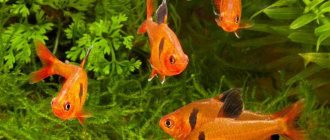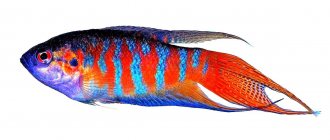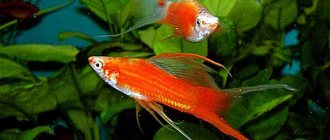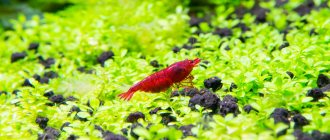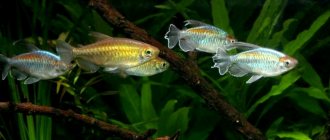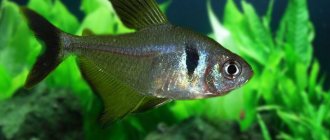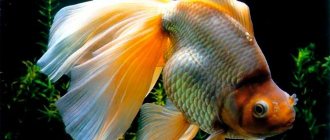Habitat in nature
Swordfish (Xiphophorus helleri) is a freshwater species of the family Poeciliidae. Native to Central America from southern Mexico to Guatemala. X. hellerii has become a nuisance pest as an introduced species in a number of countries. It has caused environmental damage due to its ability to multiply quickly in large numbers. Wild populations have become established in southern Africa, including Natal, Hawaii, Madagascar and Eastern Transvaal in South Africa, and Lake Otjikoto in Namibia.
They live in nature in various reservoirs, both with running and standing water. The swordtail prefers fast-flowing, densely vegetated rivers and streams, but is also found in warm springs and canals. An omnivore, it feeds on both plants and small crustaceans, insects and annelids.
They prefer shallow, abundantly overgrown places where they feed on various insects, algae and detritus.
Types of swordtails
A rare species is the Clemencia swordtail. His homeland is Mexico. It is distinguished by a yellow tail with a black edging, the color of the scales is pinkish with a blue tint, the body size is 4-5 cm without a fin.
Also known is Ada, a hybrid of the green swordtail. It has a black tail and a silver body. The length of the tail in males reaches the size of the fish itself.
Alvarez's swordtail is blue. There are 2 red stripes on the body. The length of adults is 4-5 cm.
The tiger swordtail is speckled ruby with black spots. This species was bred in Russia. If you want to breed such fish at home, take into account the color of the tail: do not buy a fish if it is pure black.
The rarest expensive one is the Montezuma swordtail. Costs at least $100 per pair. Another name is royal. It got its name because of its fan-shaped fin, yellow with black speckles. The color of the scales is golden. The tail is long, with a black edge.
We recommend reading
Keeping clown fish and its compatibility with other fish
Description
Swordtails can grow quite large. The male swordtail grows to a maximum total length of 14 centimeters, and the female up to 16 centimeters. But, usually in aquariums they are smaller, this very much depends on the species and conditions of detention. They live in an aquarium from 3 to 5 years.
The name "swordtail" comes from the elongated lower lobe of the male's caudal fin. Sexual dimorphism is moderate, the female is larger than the male, but lacks a “sword”. The wild form is olive green in color, with a red or brown lateral stripe and speckling on the dorsal and sometimes caudal fins. Captive breeding has produced many colored varieties, it is difficult to single out just one form, although the most popular would be the red with black tail.
And so they are red, green, black, albino, spotted, yellow. Describing them all is quite a difficult task.
But anyone who has ever seen an aquarium can imagine what a swordtail looks like. This fish is so common.
Diseases and treatment of swordtails
Swordtails are very resilient fish and can withstand harsh conditions. However, like all living beings, such excellent health does not last forever. The key to successfully keeping fish is to ensure optimal aquarium water conditions.
Swordtails are susceptible to all the typical diseases of aquarium fish and there are no nuances in their treatment.
For proper and correct treatment of swordtails, it is necessary to diagnose the disease, and then apply the necessary procedures. Treatment and diseases of aquarium fish and sections of the site will help you with this FISH DISEASES, AQUA.MEDICINE.
Difficulty in content
One of the most popular fish among beginner aquarists. Unpretentious, not too big, easy to breed. The good news is that this fish is easy to care for. Swordtails are hardy and can survive almost all the mistakes of beginners.
Disadvantages include the pugnacity of some males, especially among themselves.
It is best to keep swordtails in aquariums with plenty of plants and free space for swimming. Floating plants will create diffused light and provide cover for the fry.
They tolerate brackish water well, so they can be kept in low salinity conditions. These fish are viviparous, which means that they store their eggs inside their body and the fry that are born are completely ready for life.
Swordtails are a widely traded species, so you are likely to find them at your local pet store.
Once in your aquarium, they can live up to 5 years.
Price
The aquarium swordtail fish is an inexpensive species. The price for them ranges from 50-300 rubles and depends on the age of the fish, its morph, origin and purity of the line. Thoroughbred fish, for the breeding of which a careful selection of parental pairs was used, will cost more than individuals obtained as a result of random crossing of representatives of different morphs. Adult fish, ready to breed, are more expensive than fry.
Swordtails are beautiful and interesting fish to watch. They are easy to keep and are well suited as the first inhabitants of a beginner's aquarium. For experienced aquarists, this species may be of interest from the point of view of obtaining new breeding varieties. With proper care, swordtails live quite a long time, bringing numerous offspring during their lives. If you liked the article or have something to add, leave your comments.
Feeding
You can feed them flakes, live or frozen food, and other aquarium fish foods. Like all fish, swordtails require a varied diet.
It is especially important to feed them plant foods high in fiber.
The fact is that in nature, most of the diet of swordtails consists of thin and fragile algae and other fouling. In the wild, their omnivorous diet also includes insect larvae, plankton and other organisms.
This amount of algae will be excessive in an aquarium, but you can always buy flakes with a plant component.
You can make such flakes the basis of the diet, and live food as additional nutrition. Any live food can be given; swordtails are completely unpretentious.
However, when young, they need a lot of protein. This means that live or frozen foods such as bloodworms, daphnia and brine shrimp are important supplements to the diet.
Feed your swordtails 2-3 times a day. They don't need much food, just what they can eat within a few minutes. Remove any remaining food to prevent it from decomposing and contaminating the water.
If you stick to a regular routine, they will soon learn when to expect food and will become much more active during feeding times.
Water parameters and precautions
Plant algae to increase oxygen production. From the soil, use pebbles and seashells in the aquarium. Nimble, playful fish sometimes jump out of the aquarium, so cover it with a lid. If the aquarium is large, provide aeration and install a filter. If it is designed for 5-6 fish, this is not necessary.
We recommend reading
Types and content of synodontis catfish
Maintenance should be carried out at a water temperature of 23-25 degrees. Although the fish can tolerate temperatures down to 17-18 degrees. Water hardness is 8-25 dH, acidity level is 7-8 pH.
It is important to keep the water parameters in the aquarium under control, so it is recommended to purchase devices for measuring them.
Maintenance and care in the aquarium
Swordtails are very unpretentious in maintenance. Swordtails are hardy creatures, but they must be kept in an environment that matches their natural tropical freshwater habitat. In an aquarium with a volume of 35 liters you can keep one swordtail, but this is a very active fish and the larger the volume, the better.
Remember that for breeding you need to keep one male and 2-3 females, but if there is 1 male and 1 female, then the male can drive her to death.
And try not to buy several males for one aquarium, since swordtails have a pronounced hierarchy. The main male will always chase the others, and this means fights, injuries, chaos.
Swordtails are quite unpretentious when it comes to temperature and can live at both 18°C and 28°C. Ideal would be 23-25°C.
Parameters such as hardness and pH are not very important for them, but they feel better in water of medium hardness and at a pH of 6.8-7.8.
It is advisable that the aquarium has filtration; an internal filter is sufficient. It is necessary to change the water with fresh water, approximately 20% weekly.
But keep in mind that in addition to the swordtail swims very quickly, it also jumps well. The aquarium must be covered, otherwise you risk finding a dried corpse.
How to decorate an aquarium - to your taste.
The only thing is that it is desirable that it be densely planted with plants, since swordtails love such aquariums, and in the bushes it is easier to hide from the aggression of males.
The substrate does not matter, since swordtails rarely venture to the bottom. Use sandy substrates if you want to replicate their habitat as closely as possible.
Plants are an important addition since these fish need to hide when they feel stressed. Place them throughout the tank, but be sure to leave plenty of room for them to swim.
Feeding and diet of swordtails
Swordtails are unpretentious in food, they are omnivores and prone to overeating. They enjoy eating dry and freeze-dried food: flakes, granules, chips. You can easily use Tetramine as a base feed. And additionally feed containing carotenoids.
Allow me to make a small note. Color series food - enhances the natural color of fish (red, yellow colors), as it is enriched with pigments such as canthaxanthin, astaxanthin . In fact, carotenoids are natural “coloring” substances. It is astaxanthin that gives plants their red-orange color, carrots are a prime example of this. Or, for example, have you ever wondered why flamingos are pink? Yes, that's exactly why. By eating plant and animal foods rich in carotenoids, the flamingo's plumage, which is initially white, gradually turns pink. The more birds receive this substance from food, the richer and redder the plumage becomes. If you look even deeper, flamingos eat the well-known brine shrimp - pink, saltwater crustaceans and also turn pink.
Actually, the same thing happens to fish if the food contains carotenoids. We also note that astaxanthin also has other beneficial properties - it is also an antioxidant. In general, we can say that carotenoids are beneficial not only for fish, but also for all aquatic organisms, even aquarium plants. The only thing is that everything should be in moderation and balanced. You need to understand that the color of the fish also depends on the state of health, environment, life circumstances (stress/spawning) and the characteristics of the aquarium lighting.
Actually, to summarize, the Color series food is good, but should not be a basic diet. Imagine what will happen to a person who eats only one beet all week =) It’s scary to imagine. The same goes for the fish... sorry, they start pooping cute pink poop.
In this matter, by the way, it is very important not to overfeed the fish, so as not to run into problems with the gastrointestinal tract. Feed the swords once a day, do fasting days. This will be one of the keys to success in their maintenance. It should be noted that when purchasing any dry food, you should pay attention to the date of its manufacture and shelf life, try not to buy food in bulk, and also store the food in a closed state - this will help to avoid the development of pathogenic flora in it.
Compatibility
Old males can attack other fish, but this depends on the individual. Some live quite peacefully, while others become violent.
Aggression is promoted by cramped aquariums without plants. What you definitely shouldn't do is keep two or more males in one aquarium. This leads to guaranteed fights. Males tend to be aggressive towards each other, so smaller tanks only keep one male.
A larger tank can accommodate more males - make sure the ratio is one male to four females.
Who do they get along with? With viviparous animals: guppies, platies, mollies. They get along well with a variety of spawning fish: angelfish, gouramis, neons, and irises.
But it’s better not to keep them with goldfish...
Gold requires colder water, and swords are restless neighbors. Swordtails can become timid if kept with aggressive fish and will hide among plants and decor.
You must avoid aggressive species that can attack and injure your swordtails. This rules out most cichlids such as the diamond or black banded cichlids.
Swordtails are not gregarious, but they are sociable and love to be in a group of their own kind.
Division by fin shapes
Breeders worked not only on fish colors. They are also divided into species according to tail shape. There are pets:
- lyrebirds;
- sailing;
- forked;
- flag;
- veil.
The large fin of male lyrebirds resembles a famous musical instrument. The forked tail is like the first, but there are three “swords”, not two.
Flagbacks have an interesting shaped fin that stands out even more than the tail. Russian aquarists are well aware of the variety of these fish - the flag ruby, or the flag red swordtail.
All veil fins are elongated and look like fringes. They are slower than other species and do not like fighting as much.
Sex differences
It is extremely easy to distinguish males from females in swordtails. Only the male has a sword on the caudal fin, the long outgrowth from which the fish got its name.
Also, in all viviparous animals, the anal fin of the male is pointed and narrow (gonopodium), and the anal fin of the female is wide.
Quite often it happens that a female swordtail suddenly grows a sword and becomes a male! At the same time, she behaves like a male, cares for other females, but is infertile.
The reasons for this phenomenon are not completely clear.
Reproduction and breeding of black swordtails
Breeding and propagating swordtails is absolutely not a difficult task. It is similar to the reproduction of guppies and other livebearers . And, one might say, it actually happens on its own.
Sexual maturity in swordtails occurs at the age of 5-6 months. For breeding (and for their own comfort), it is recommended to keep fish in a ratio of one male to three females. In the process of courting a female, the male performs a kind of courtship dance - shuttle movements back and forth.
Fertilization of mature eggs occurs inside the female. This process may take several days. An interesting feature is that a once fertilized female swordtail can give birth to offspring several more times, even in the absence of a male.
The duration of a female's pregnancy is 4-6 weeks. This period depends on the parameters of the aquarium water, temperature, lighting and feeding.
The pregnant female has a full abdomen and a "black pregnancy spot" under her tail. It is believed that a few hours before the “birth” the female’s belly becomes “square”, the female begins to move more actively, “throwing” up and down along the aquarium glass.
At one time, the female spawns from 15 to 100 or more fry. Spawning usually occurs in the morning.
With plenty of nutrition and a water temperature of 26-27° C, birth can occur monthly.
Perhaps the most important rule to follow when breeding swordtails is concern for the survival of the young. Unfortunately, the producers eat their own offspring, and given that the fry of swordtails are quite large in size and brightly colored, this process simply turns into extermination. In nature, swordtails never see their offspring, because... The fry is immediately carried away by the current. In the aquarium, the parents mistake the fry for food.
To preserve the offspring, I plant the aquarium densely with aquarium plants. Plants are placed at the bottom of the aquarium, in the water column and especially densely on the surface. Thus, the fry are provided with shelter “from evil parents” and most of the fry survive.
Also, to preserve the offspring, you can use special aquariums, which are designed like a funnel - the female remains in the funnel, and the swept juveniles fall out of the funnel into the spawning aquarium. Thus, initially the absence of contact between the breeder and the fry is ensured.
The third option for preserving offspring is spawning spawners immediately after spawning. This option is simple, but requires attention and timeliness from the aquarist.
Photo of a pregnant female swordtail, here she is giving birth
Deeply pregnant female swordtail =)
After spawning, the female is removed and provided with abundant feeding.
The initial food for juvenile swordtails is live dust (nauplii, brine shrimp, cyclops, microworm, rotifers, cut tubifex).
After a week, the juvenile swordtails begin to be weeded out - divided into strong and “thoroughbred” ones, and the weak and defective ones are destroyed.
The juveniles grow quickly; after two months, the anal fin of the males begins to change, and by the third month the “sword” begins to grow.
When keeping swordtails of different species, independent crossing occurs, as a result of which you can sometimes get beautiful offspring.
An interesting fact from the life of these fish is that the female swordtail can at some point become a male, i.e. change gender This occurs under conditions of a “shortage” of males and is explained by the struggle for the survival of the species. The offspring of a female + former female pair consists of almost 90% females.
Artificially bred forms
Green
Another name for this species is the common swordtail (Gellera).
It was these specimens that were first caught in Guatemala and Mexico in 1909, which served as the beginning for aquarium breeding and selection work. The green swordtail has a long and narrow body that is slightly flattened on the sides. The difference between males, which gave rise to the name, is a long growth on the tail, reminiscent of a sword. In their natural habitat, males grow up to 8 cm in length, females are slightly larger - up to 12 cm.
The color of wild individuals is not bright. The main background is grayish-olive; males have a longitudinal red stripe running from the gill covers to the base of the tail. Parallel to this stripe, paler and thinner stripes of a similar color may appear. The tail and fins are translucent, painted in a dull yellowish or brownish color. The sword of males has a dark edge.
The females of this species are paler in color, this is especially noticeable during the period of courtship, when the males “dance” in front of their chosen ones, showing themselves in all their glory.
Today, it is very rare to find a pure (uncrossed) specimen of the green swordtail. Such a fish will cost a lot of money, since it is a valuable material for breeding.
Red
The most popular type of swordtail obtained artificially is red.
The rich scarlet color is the result of repeated crossing of the common swordtail with red platies. The first hybrid generations had yellowish and whitish shades in the chest and abdomen, but in modern reds this defect has long been eliminated. The bright, stable color of the red swordtail allowed us to give it another beautiful name - ruby swordtail. In many Western catalogs there is also such a name as vampire swordtail, which the fish received due to the color of its eyes.
One of the most common subspecies of red is the red black-tailed or Prussian swordtail. These fish are distinguished by their black, velvet-like tail and dorsal fin. A school of such fish looks very impressive against the backdrop of dense vegetation.
Other spectacular species of the red form are the red dragon swordtail and the highfin red.
Black
The black swordtail was first obtained by breeders G.V. Samokhvalova. and Maranchak V.M. back in 1946. It was the result of crossing male black platies with female green swordtails. Most of the females from the first generation, unfortunately, turned out to be infertile. The second stage was the crossing of black swordtails (males) with green females. Thus, ichthyological breeders have achieved the emergence of a new variety of swordtails with a dominant black color in color.
Citric
The lemon swordtail is an albinistic form of the common green swordtail. The unusual yellow color of these aquarium fish has made them extremely popular. However, this subspecies is considered very unstable and difficult to breed; their mortality rate is quite high. White Bulgarian swordtails, similar to this subspecies, are also albino, but they are more viable.
Bulgarian white
One of the forms of swordtails is albino. It is characterized by high survival rate and unpretentiousness to living conditions.
Calico
Calico swordtails are distinguished by their tricolor color: contrasting black and red spots are scattered across the white and cream main background. As with lemon swordtails, calicos are very difficult to breed because only a few of the fry in the litter are correctly colored. For about 15 years, specialists have been unable to fix and stabilize this color.
Cuban
There is still heated debate about this species of swordtail.
It is called the Cuban swordtail only by domestic aquarists, but in the West it is called red-black. There are two versions of the appearance of such a hybrid. According to the first version, the spotted platypecilia and the red swordtail were involved in the breeding; according to another version, the red, black and green swordtail. One way or another, the result was a fish with a red main body and fins and a characteristic black oblong spot running along the lateral line from the gills to the tail.
Rainbow
The rainbow form is a hybrid of the white Bulgarian. The fish are distinguished by their gray-green scales with an orange tint and the presence of red-brown stripes. The fins and tail are also painted a rich brick red color. Such elegant fish will decorate any aquarium.
Pineapple
The pineapple swordtail is the result of selection of the green swordtail. The body color is predominantly yellow-lemon, with a contrasting scarlet stripe running along the lateral line. Above and below it you can see similar, but thinner stripes. The color of the sword in males can vary from yellow to bright red and has a distinct dark edge.
Red speckled brindle
This breed was bred in Moscow in the 40s of the last century. The color of the fish is ruby with black specks throughout the body. An excess of pigment (melanosis) in the tiger swordtail is quite rare, however, for breeding it is better not to take breeders with a purely black tail.
Hell's Swordsman
A black and white, artificially bred form derived from green. The body is silvery-white in color, while the fins are charcoal-black in color. The length of the sword of the males of this hybrid can be equal to the size of the fish itself.
Koi Kohaku
Another name for this hybrid is Santa Claus swordtail. The head and tail of the fish are a bright carrot color, while the middle is a soft white-cream color. Adult koi in an aquarium can reach a length of up to 10 cm.
Mountain
This subspecies is colored creamy-yellow and has pronounced mottling on the sides of the body. From a certain angle, the scales give off a purple sheen. The fins are translucent, yellowish, the dorsal fin is covered with black dots. The sword of males is outlined black around the edges.
Pygmy swordtail (Xiphophorus pygmaeus)
Pygmy swordtail
There are several more poorly studied species of swordtails. And all other swords are artificially bred breeds. Some of them are imitation of Montezuma and Alvarez swordtails, obtained artificially. Let's say the Berlin swordtail is a hybrid of Heller's swordtail and the red black-finned artificial breed of spotted platie Xiphophorus maculatus.
Keeping swordtails, conditions requirements
Common swordtail Xiphophorus helleri (close to wild-caught species)
- pH 7.0-8.0
- dH 9-19
- tC 22-28
- Grows up to 14 cm
Montezuma's swordtail Xiphophorus montezumae
- pH 7.0-7.5
- dH 10-20
- tC 20-26
- Grows up to 6.5 cm
And in this video, just those swordtails and guppies fry that you saw in the photo above. The video is really not very good quality. One of the first ones I shot.
Dietary supplements and compatibility with other fish
Swordtails are not averse to feeding on aquarium vegetation. They prefer to eat thin, fragile algae. This is normal for them. Offer any type of food to your pets as live food. Supplements in the form of greens and other products are also welcome. This can be either finely chopped nettle or spinach leaves scalded with boiling water, or food that is non-standard for swordtails: chopped boiled fish, crackers, egg yolk.
It is recommended to feed the fish 2 times a day. Keep in mind that swordtails easily overeat, so do not overfeed them and serve food in large portions. It is also advisable to have a fasting day once a week. During this period, food is not given at all. In such conditions, the fish’s body is cleansed.
We recommend reading
What you need to know about breeding betta fish
Since swordtails are not the most peaceful neighbors, they need to be housed with those who are larger or identical in size. These are barbs, gourami, neons, angelfish. But you shouldn’t keep restless fish near astronotuses and coicichlids.

